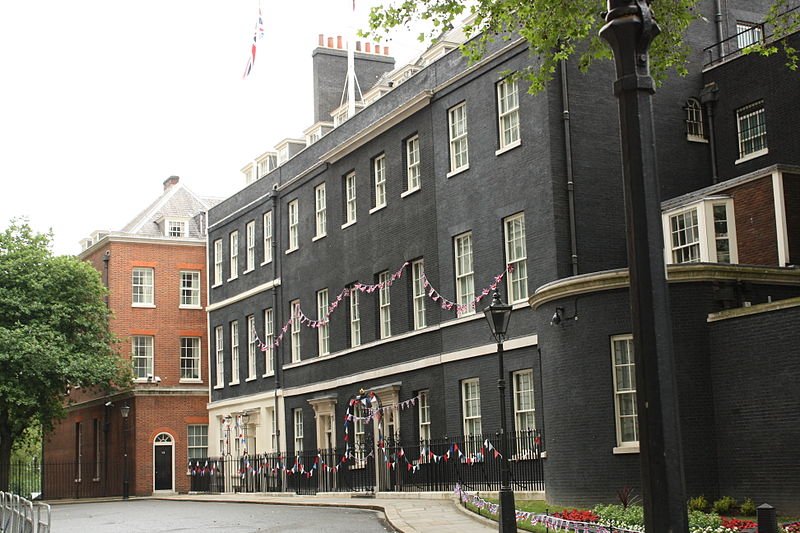
10 Downing Street on Google Street View
(Sep 2014)10 Downing Street (GPS: 51.50336, -0.12762) is the official residence and office of the Prime Minister of the United Kingdom, as well as the headquarters of the British Government. Located on a short street in the City of Westminster, London, 10 Downing Street refers to the residence of the First Lord of the Treasury, a position that is traditionally held by the Prime Minister. As such, it is commonly regarded as the Prime Minister's residence.
Number 10 Downing Street serves as both the residence and workplace of the Prime Minister. It houses the offices of secretaries, assistants, and advisors, as well as conference and dining rooms where the Prime Minister meets with and entertains leaders and foreign dignitaries. The building is situated close to the Palace of Westminster, the UK Parliament, and Buckingham Palace, the residence of the monarch.
The structure of Number 10 originally consisted of three separate houses: the "house at the back," the "Number 10" itself, and the neighboring property. The house at the back was a mansion built around 1530, next to the Palace of Whitehall, the main residence of the monarchs at that time. Number 10, constructed in 1685, was smaller and originally one of the royal properties used by various members of the royal family.
In 1732, King George II offered Number 10 to Robert Walpole, who is regarded as the first Prime Minister of Great Britain. Walpole accepted the offer on the condition that the property be a gift to the office of the First Lord of the Treasury, not to him personally. The monarch agreed, and thus, 10 Downing Street became the official residence for each incoming First Lord.
Although it became the Prime Minister's residence, 10 Downing Street was not without its challenges. Built on boggy soil, it was costly to maintain, and many Prime Ministers chose not to live there. William Pitt the Younger, who lived at Number 10 for 19 years, longer than any other Prime Minister before or since, described the house as a "vast, awkward house" in a letter to his mother. Arthur Wellesley, the Duke of Wellington, famously refused to live there, finding it too small. There were several occasions when 10 Downing Street nearly faced demolition, but as time passed, its historic significance grew, and it became a symbol of British governance.
Over the years, the walls between the houses on Downing Street were removed, linking them together, making it difficult to discern where one house ends and another begins. This expansion continued with the adjacent houses on Horseguards Parade, eventually creating a vast, labyrinthine complex.
The perception that the Prime Minister lived at 10 Downing Street was often maintained even when they resided elsewhere. For example, during his second term as Prime Minister (1974-1976), Harold Wilson preferred to live in his private home on Lord North Street. However, with the help of the media, he maintained the appearance of living at Number 10, often entering the front door before exiting through the side door to return home.
After the 1997 General Election, when Tony Blair became Prime Minister, he and his Chancellor, Gordon Brown, swapped residences. Blair, who had a wife and three children, took up residence in the more spacious Number 11, while Brown, who was unmarried at the time, lived in the smaller quarters of Number 10. Later, after Brown married and Blair had a fourth child, Brown moved to a private flat, and the Blair family occupied both Number 10 and Number 11.
The iconic black front door at Number 10 has no keyhole – it can only be opened from the inside. A security guard is stationed behind the door to open it for the Prime Minister, regardless of the time of day or night. During Margaret Thatcher's premiership, gates were installed at both ends of Downing Street, with armed police on guard. While public access to Downing Street is restricted, visitors are allowed entry after passing security checks and following certain rules.
Getting there
Nearest Tube Stations: Charing Cross Tube Station and Westminster Tube StationBuses: 11, 12, 24, 88, 159
Access: View from gate at road entrance
Britain Visitor Centre: 1 Lower Regent St, Piccadilly Circus SW1Y 4XT
10 Downing Street is  on the Map of the City of Westminster, London
on the Map of the City of Westminster, London
 10 Downing Street, London
10 Downing Street, LondonSource: https://commons.wikimedia.org/wiki/File:Downing_Street_from_Treasury_Green_1.JPG
Author: Richard Symonds

List of Tourist Attractions in London
 Map of Streets in London
Map of Streets in London
The streets that I have described are marked in the map below in red. To read about the street, point your cursor to the red line and click.List of Streets in London
 Map of London Boroughs
Map of London Boroughs
 Latest updates on Penang Travel Tips
Latest updates on Penang Travel Tips
About this website

Dear visitor, thank you so much for reading this page. My name is Timothy Tye and my hobby is to find out about places, write about them and share the information with you on this website. I have been writing this site since 5 January 2003. Originally (from 2003 until 2009, the site was called AsiaExplorers. I changed the name to Penang Travel Tips in 2009, even though I describe more than just Penang but everywhere I go (I often need to tell people that "Penang Travel Tips" is not just information about Penang, but information written in Penang), especially places in Malaysia and Singapore, and in all the years since 2003, I have described over 20,000 places.
While I try my best to provide you information as accurate as I can get it to be, I do apologize for any errors and for outdated information which I am unaware. Nevertheless, I hope that what I have described here will be useful to you.
To get to know me better, do follow me on Facebook!
Copyright © 2003-2025 Timothy Tye. All Rights Reserved.

 Go Back
Go Back